Fort George G. Meade: The First 100 Years
You may know Fort George G. Meade as a cyber and intelligence hub, but did you know that the installation used to be the home of Army Tank School after World War I? Or that it housed an internment camp at the start of World War II for primarily German-American and Italian-American citizens and foreign nationals? Learn more about the fascinating history of the third largest Army base in the U.S. in terms of number of workforce in this book.
You may know Fort George G. Meade as a cyber and intelligence hub, but did you know that the installation used to be the home of Army Tank School after World War I? Or that it housed an internment camp at the start of World War II for primarily German-American and Italian-American citizens and foreign nationals? Learn more about the fascinating history of the third largest Army base in the U.S. in terms of number of workforce in this book.
Create successful ePaper yourself
Turn your PDF publications into a flip-book with our unique Google optimized e-Paper software.
<strong>The</strong> Garrison Prepares for War<br />
GULF WAR<br />
243<br />
Before the Storm<br />
In 1990 <strong>Fort</strong> <strong>George</strong> G. <strong>Meade</strong> was a Forces Command<br />
installation and the home of Headquarters, <strong>First</strong><br />
United States Army. <strong>The</strong> garrison supported three subinstallations:<br />
<strong>Fort</strong> Indiantown Gap, <strong>Fort</strong> A.P. Hill and the<br />
Charles E. Kelly Support Facility in Pittsburg, Pennsylvania<br />
<strong>The</strong> installation population was approximately 43,000 and<br />
at the time, was an “open post” with no manned gates.<br />
Even in 1990, the installation still possessed more than<br />
three million square feet of WWI and WWII wooden<br />
structures, to include more than one hundred barracks<br />
buildings. <strong>The</strong> threat that <strong>Fort</strong> <strong>Meade</strong> could be shuttered<br />
through Base Realignment and Closure action did not<br />
incentivize the Army to provide the necessary funding<br />
to maintain or improve these buildings. As a result,<br />
most of the fifty years and older structures were poorly<br />
maintained.<br />
Five thousand acres of training areas and firing ranges<br />
meant <strong>Fort</strong> <strong>Meade</strong> remained a valuable Army asset. At the<br />
time, more than 64 units and 147,000 personnel utilized<br />
these facilities for maneuver and weapons training.<br />
<strong>The</strong> garrison staff was relatively large, with a staff of<br />
approximately 2,700 military personnel and government<br />
service civilians. Major organizations included the 519th<br />
Military Police Battalion, 85th Medical Battalion, U. S.<br />
Army Garrison Headquarters Battalion, Office of Reserve<br />
Component Support, Tipton Army Airfield, a Regional<br />
Contracting Office and a Direct Support/General<br />
Support Maintenance Facility.<br />
During the Storm<br />
Such was the makeup of the installation when, on Aug.<br />
2, 1990, Iraqi troops invaded Kuwait. Five days later, on<br />
August 7, the first US troops arrived in Saudi Arabia and<br />
the United States launched Operation Desert Shield.<br />
As a result, the garrison began to prepare for the<br />
possibility of mobilizing forty-five Reserve and National<br />
Guard units including the deployment of its own 519th<br />
Military Police Battalion.<br />
<strong>The</strong> Garrison Mobilization Plan called for the activation<br />
of a Reserve component garrison headquarters to assist<br />
By Lynn Sasser and Kent Menser<br />
with the process. As often happens, plans changed and<br />
a Reserve headquarters element was never assigned to<br />
the task. Instead, the installation created a Mobilization<br />
Headquarters to fulfil the requirement. <strong>The</strong> organization<br />
was led by an Army Maintenance officer, who became<br />
the MOB HQs Commander; a Civilian Logistics Program<br />
Analyst Officer became the MOB HQs Executive Officer;<br />
and a Civilian Maintenance & Repair Supervisor, became<br />
the MOB HQs Logistics Officer. All were from the <strong>Fort</strong><br />
<strong>Meade</strong> Directorate of Logistics and none of them had<br />
prior experience mobilizing units. In their favor, they were<br />
Viet Nam War tested senior non-commissioned officers<br />
and officers that were supported by a knowledgeable<br />
and resilient government workforce. <strong>The</strong>y faced their<br />
gargantuan task with determination to execute.<br />
To complicate matters further, the garrison received<br />
notice that two of our three garrison battalions had been<br />
ordered to deploy to the gulf. We were not surprised that<br />
the 519th MP Battalion, an 18th Airborne Corps asset,<br />
was going, but the deployment of the 85th Medical<br />
Battalion was a shock to everyone. Much of their mission<br />
was imbedded into the installation’s Kimbrough Army<br />
Hospital and they had not deployed overseas since WWII.<br />
<strong>The</strong> 519th completed its deployment preparation on Oct.<br />
7, and the 85th was “wheels up” only ten days later, on<br />
Oct. 17, 1990.<br />
Looking back on the amazing Desert Storm Victory, it<br />
is easy to lose sight of our command’s concerns during<br />
that intense September. All we knew was that we were<br />
sending two of our battalions to join the fight with the<br />
fourth largest land Army in the world, which possessed<br />
a significant chemical warfare capability. Because of the<br />
lack of mission specifics, we focused all of our resources,<br />
time, money and people, on unit readiness. We secured<br />
every item of equipment we thought our units might need<br />
if they found themselves without support upon their<br />
arrival “in country.”<br />
In just one example, we knew lack of terrain features<br />
was going to make navigation tough in the desert and<br />
at that time Global Positioning Systems were not in<br />
the Army inventory even though the systems were just


